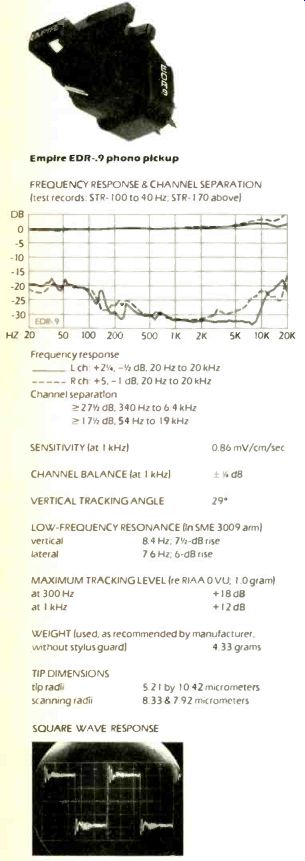
Empire EDR-.9 fixed-coil phono cartridge with L.A.C. (Large Area Contact) diamond stylus.
Price: $200.
Warranty: "limited," two years parts and labor.
Manufacturer:
Empire Scientific Corp., 1055 Stewart Ave., Garden City, N.Y. 11530.
Considering the vagaries of taste and hearing, compounded by the difficulties a cartridge presents in objective lab tests, it is to Empire's credit that its new top-of-the-line pickup emerged impressive on all counts. A fixed-coil design, the EDR-.9 is the most costly cartridge ever produced by Empire and incorporates some new design principles.
Many of today's fixed-coil cartridges control high-frequency mechanical resonance by relying on the capacitance of the phono preamp to create what might be thought of as an electrical antiresonance and thus work best only within a circumscribed range of loading conditions. Empire's approach is to insert a miniature iron bar within the hollow cantilever tube. The bar moves only in a specific range of frequencies and acts as an inertial damper, filtering out high-frequency peaks. Since this arrangement does not depend on preamp capacitance, the company claims that the EDR-.9 can operate into a wide range of loads without audible ill effects. Data from CBS Technology Center, using the STR-1 70 and loading the pickup with 100 picofarads (a common value of turntable-lead capacitance), show some peaking around 10 kHz. In listening tests, however, we noticed a pronounced smoothing of the sometimes sibilant character of other top-quality pickups. And overall frequency response of the pickup is extremely flat.
Another departure in this cartridge is the configuration of its stylus tip, which resembles the Shibata: Its contact area is spread up and down the groove walls, with a much smaller dimension front to back. CBS's inspection indicates fair polish and good alignment of the nude-mounted diamond tip. The vertical tracking angle was measured by CBS's new method, of course, and therefore should not be compared with the lower but less accurate figures published prior to last June.
According to CBS, the EDR-.9 negotiated the sweep-tone torture test with a minuscule vertical tracking force of 0.55 gram. Using a 1-gram VTF (the mean of Empire's recommended tracking force range), the cartridge maintains good separation and response that cannot be called "peaky," despite the rising high end of the test results and though the ringing visible in the square-wave photo does not appear to be far beyond 20 kHz. Low-frequency resonance falls a hair below the 10-Hz ideal, suggesting that a tonearm somewhat less massive than our standard SME would be a good choice.
In comparison to other cartridges, it took some getting used to in our listening tests, since its distinction lies in not being distinctive. A/B comparisons between it and another fine pickup, for example, show the Empire markedly less disposed to dramatize sibilants and other high-frequency effects. Instrumental timbres come across in all their details, without any artificial emphasis. Voices appear open and full, with just enough presence; bass notes are solid and well defined.
We were even impressed with the packaging: A vinyl lens case snaps open to reveal the cartridge, a screwdriver, mounting hardware, stylus brush, and cleaning liquid. More important, of course, the EDR-.9 reproduces music with accuracy and nuance, making it a strong contender for those choosing a high-quality, high-priced phono cartridge.
(High Fidelity, Oct. 1979)
Also see:
Empire's EDR.9 phono cartridge (ad)